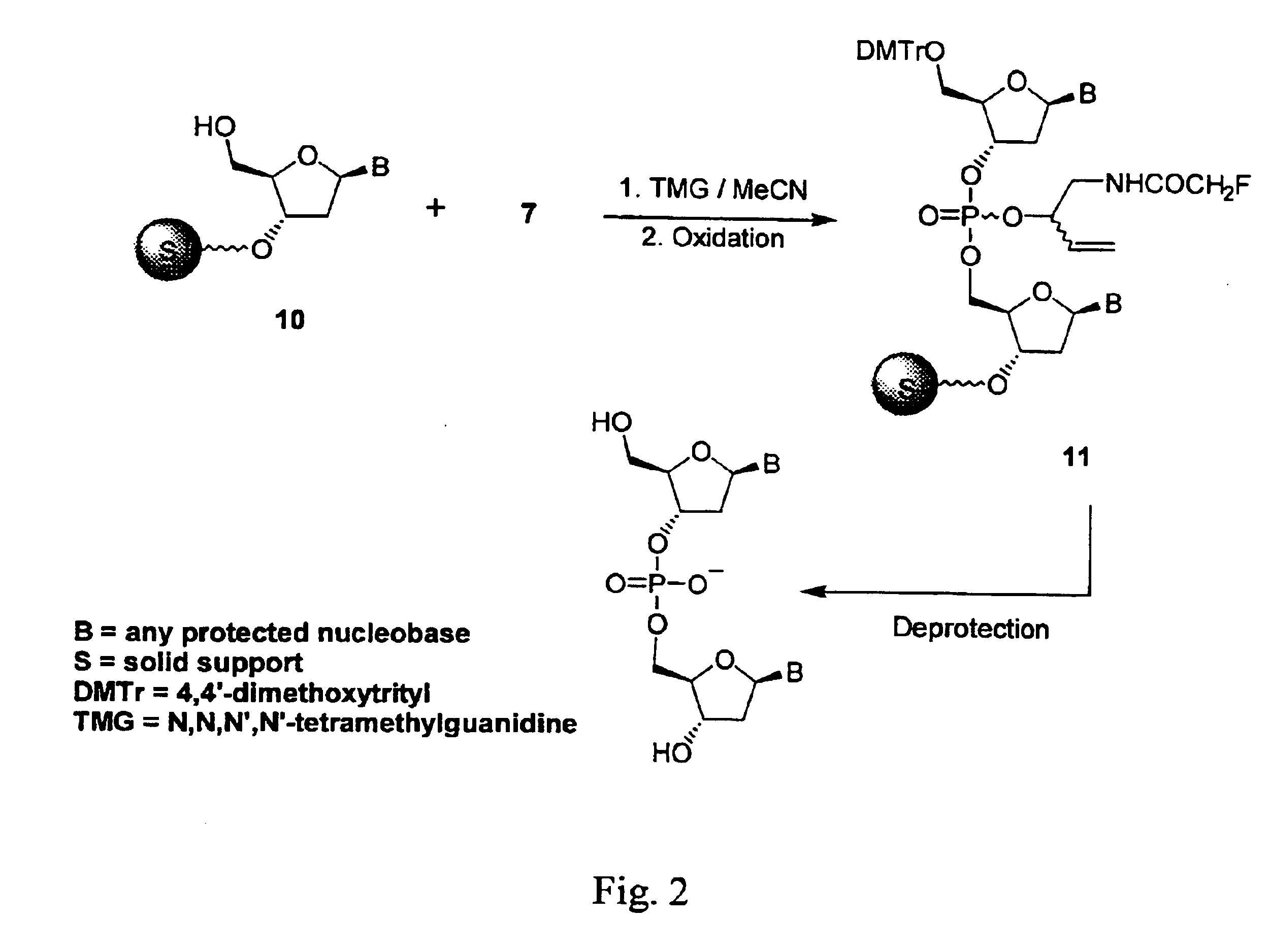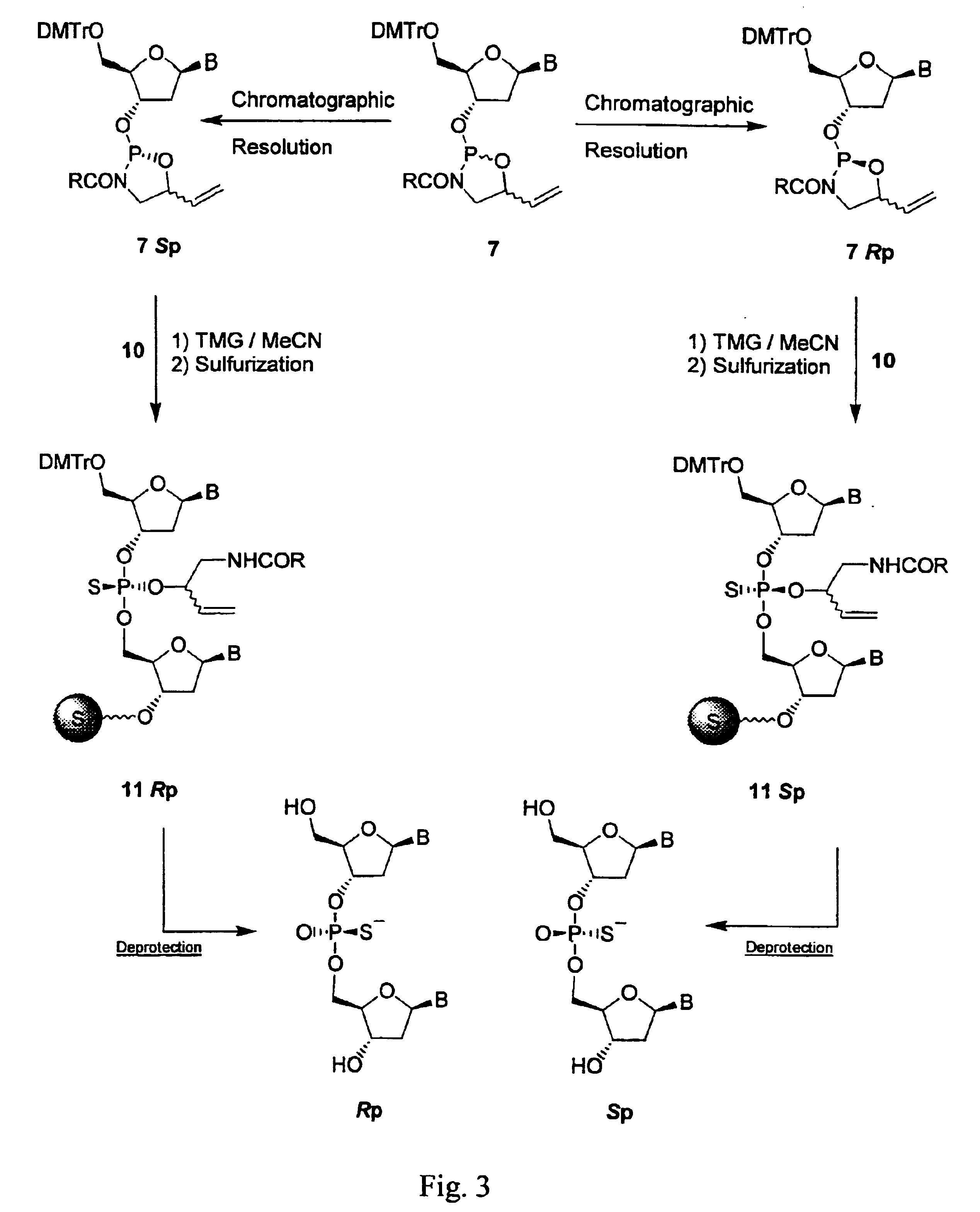N-acylphosphoramidites and their use in oligonucleotide synthesis
a technology of acylphosphoramidite and oligonucleotide, which is applied in the field of oligonucleotide synthesis, can solve the problems of complex mixtures of diastereomers, limited to the synthesis of very short oligomers, and limited applicability of approaches
- Summary
- Abstract
- Description
- Claims
- Application Information
AI Technical Summary
Benefits of technology
Problems solved by technology
Method used
Image
Examples
example 1
[0137]This example illustrates a general synthesis of the compounds of the present invention. The reaction schemes referenced in this example are generally illustrated in FIG. 1.
[0138]Typically, the synthon precursor 5 (FIG. 1) is synthesized by first refluxing a mixture of acrolein (1), trimethylsilyl cyanide, and catalytic amounts of zinc iodide according to the procedure reported by Gardrat et al. (J. Heterocyclic Chem. 1990, 27, 811). Reduction of the resulting nitrile 2 with LiAlH4 in Et2O afforded amino-alcohol 3. Heating 3 with a slight excess (1.1 molar equiv) of ethyl fluoroacetate at 120° C. until all ethyl alcohol has distilled off gave the hydroxylated amide 4 in 88% yield (b.p. 83-84° C. / 0.1 torr). An equimolar solution of hexaethylphosphorus triamide and 4 was heated to 120° C. until all diethylamine has distilled off. Vacuum distillation afforded the oxazaphospholane 5 in 69% k yield.
[0139]Nucleoside cyclic acylphosphoramidite 7 was prepared by the reaction of a suita...
example 2
[0140]This example illustrates a solid phase synthesis in accordance with the present invention. The general reaction scheme is illustrated in FIG. 2, in which nucleoside cyclic acylphosphoramidite 7 (FIG. 1) is specifically applied to the manual solid-phase synthesis of a decanucleotide (dC10). A solid support is denoted in FIGS. 2 and 3 by a darkened sphere with “S” in the center.
[0141]Because of the sensitivity of standard succinyl linkers to strong bases, the first nucleoside monomer was attached to long chain alkylamine controlled pore glass (LCAA-CPG) to generate 10 has been modified. The attachment of the leader nucleoside to LCAA-CPG is accomplished via a sarcosine succinyl linkage according to the method of Brown et al. (J. Chem. Soc. Chem. Commun., p. 891-893 (1989)). A column filled with 0.2 mmol of 10, wherein the 5′-OH was protected with a DMTr group, was treated with 2.5 mL of 3% trichloroacetic acid in dichloromethane for 1 min to ensure complete cleavage of the 5′-O-...
example 3
[0143]This example illustrates the application of the synthetic “cycle” described in Example 2, in the stereospecific synthesis of oligonucleotide phosphorothioates. The reaction scheme is illustrated generally in FIG. 3.
[0144]A diastereomeric mixture of nucleosidic N-acylphosphoramidite 7 was chromatographically separated into its Rp and Sp isomers 7Rp and 7Sp, respectively. Each P-chiral isomer was coupled with nucleophilic monomer 10 (FIG. 2), using the conditions of Example 2, to provide P-chiral adducts. The coupling reactions are stereospecific. Sulfurization of the resulting adducts results in the formation of the 11Sp and 11Rp isomers, as illustrated in FIG. 3. Deprotection of the solid support and the 2-amidoethoxy fragment from the sulfurized products is therefore expected to provide stereochemically pure Rp and Sp oligonucleotide products.
[0145]It should be noted that the oxidant in the oxidation step is replaced by a sulfur-transfer reagent such as 3H-1,2-benzodithiol-3-...
PUM
| Property | Measurement | Unit |
|---|---|---|
| valence | aaaaa | aaaaa |
| length | aaaaa | aaaaa |
| nucleolytic stability | aaaaa | aaaaa |
Abstract
Description
Claims
Application Information
 Login to View More
Login to View More - R&D
- Intellectual Property
- Life Sciences
- Materials
- Tech Scout
- Unparalleled Data Quality
- Higher Quality Content
- 60% Fewer Hallucinations
Browse by: Latest US Patents, China's latest patents, Technical Efficacy Thesaurus, Application Domain, Technology Topic, Popular Technical Reports.
© 2025 PatSnap. All rights reserved.Legal|Privacy policy|Modern Slavery Act Transparency Statement|Sitemap|About US| Contact US: help@patsnap.com



